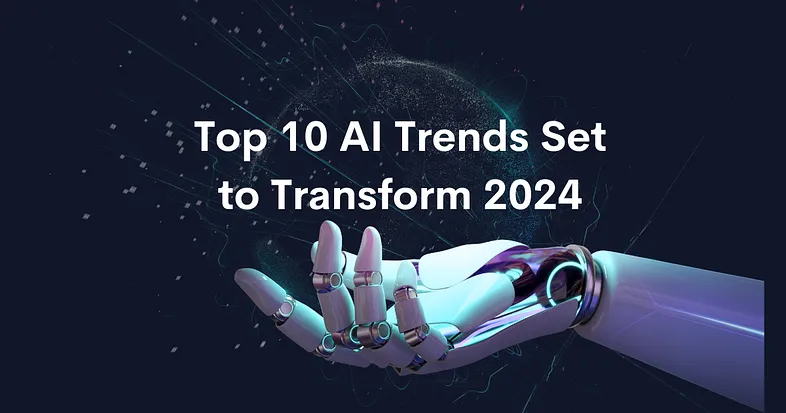
Artificial intelligence saw a radical move in 2023 with the presentation of Chat GPT in November 2022. Significant progressions in AI have been made conceivable by the advancements of the final year, which extended from a flourishing open-source environment to complex multimodal models. By 2024, counterfeit insights (AI) will proceed to development and saturate our everyday lives at a quicker rate. At a quick pace, fake insights (AI) are changing entire divisions and opening up unused trade prospects. Top AI trends are displayed in this article based on an examination of expectations made by the best investigative and innovation businesses.
Thank you for reading this post, don't forget to subscribe!Let’s discuss the top AI trends and their future ramifications for the current future.
1. Multimodal AI:
By analysing several input formats, including text, graphics, and audio, multimodal AI goes beyond conventional single-mode data processing and gets closer to simulating human abilities to process a variety of sensory data and one from the top AI trends. The GPT-4 model from OpenAI has multimodal characteristics that let the programme react to both auditory and visual inputs. When you can cross-pollinate all three—text, chat, and images—you’ll see the true value of these skills. and use them in several commercial applications
Through AI-powered restorative imaging and symptomatic advances, multimodal AI is upgrading quiet results within the healthcare industry.
Furthermore, AI common dialect preparing frameworks are getting to be capable at understanding and reacting to both content and discourse. In computer vision, fake insights applications can analyze and translate pictures and recordings, opening unused wildernesses in different industries.AI normal dialect preparing frameworks are too getting superior at comprehending and responding to voice and content. Counterfeit insights applications in computer vision are breaking unused ground over a run of segments by dissecting and translating pictures and recordings.
2. AI jobs:
The need for AI professionals is growing: according to LinkedIn’s 2020 Emerging positions Report, the top emerging positions in the US are for AI specialists, who are expected to expand at a pace of 74% annually. Good news if you want to work in AI but don’t want to be a computer scientist: a lot of new positions that fit your demands will become available in 2024. Jobs for quick engineers, who write instructions for AI applications to follow, and AI managers, who manage groups of virtual labour, will become available in addition to the engineers and technicians required to develop systems.
Various businesses, counting healthcare, keeping money, and retail, are in require for these gifts. Also, with the expanded utilize of AI-generated substance in substance promoting strategies, marketers have to be have a more grounded understanding of AI.
3. Influencers and virtual agents:
One of the top AI trends for technologies available today is the virtual agent. In this instance, AI-integrated software interacts with clients without the need for human support. In spite of the fact that innovation comes in a few shapes, voice-activated colleagues (like Alexa and Siri) and chatbots are the foremost prevalent employments. Computerized promoting is changing as a result of the rise of AI-generated influencers on social media locales like Instagram. Lil Miquela and other virtual influencers are being delivered by companies such as Brud.
With The Washington Post employing AI to create news pieces, AI-generated content is also becoming more and more prevalent in journalism. Artificial insights is additionally being utilized by major e-commerce companies like Amazon to supply item suggestions and portrayals. AI-generated substance is drastically changing the showcasing scene by making customized substance conceivable on a scale that was already unbelievable.
Virtual agents have been quickly used by AI organisations all over the world, particularly in their customer service and sales departments. By integrating them into applications and websites, these agents have allowed businesses to save time and money
4. Machine learning:
One of the AI technologies that is currently widely used in AI domains is this. The basis of machine learning is the use of several complex algorithms to train the system. For example, there is increasing demand for experts who can bridge the knowledge gap between theory and practice as AI and machine learning are incorporated into business processes.
In this procedure, a collection of training data pertaining to a certain field is provided to the computer. The computer can evaluate the information, make inferences, and “remember” it for future use by using algorithms and an iterative procedure. Any increase in the number of data sets used to aid the learning process improves the performance of machine learning algorithms. Luke stated that there is still a lot of activity in the talent market. Finding jobs in this field is rather simple.
This requires experience in a field known as machine learning operations, or MLOps, which is the implementation, monitoring, and maintenance of artificial intelligence systems in real-world environments. The idea of iterative learning and development, which originated with the Enigma machine during World War II, is not new. On the other hand, the AI revolution has made it possible to automatically analyze huge and intricate volumes of data. Additionally, it offers results organized in various ways.
5. Ethical AI:

Huge databases serve as the basis for artificial intelligence tools and systems. This data may be unreliable, contaminated, or inadequate. Future inventions may be affected by this and cause bias in manufacturing. Besides, there’s still a need of straightforwardness in fake insights innovations. Fake Intelligence has started to require the put of individuals in certain occupations.
The developing nearness of AI in our lives raises a number of ethical problems. AI processes must operate with the highest level of openness and fairness as they increasingly impact decisions, from financial advice to health assessments. And who knows, AI could get out of control in the coming years. We could witness progress in the moral use of AI by 2024.
6. Artificial intelligence in customer service:
In corporate operations, customer service is an area where many mundane, repetitive jobs occasionally mix with really important and difficult ones. This makes it the perfect testbed for incorporating AI into workflows and freeing up human time for problems that require human intervention by automating repetitive tasks. AI can be used to provide personalized solutions for typical problems, prioritize first contact calls, and create reports and summaries of customer interactions. According to a survey by Boston Consulting Group, ninety-five percent of customer service executives plan to use artificial intelligence robots to help them with customer service at some point within the next three years.
While most people fear robocalls, artificial intelligence (AI) in customer service can provide the industry with data-driven tools that deliver meaningful experiences for both providers and customers. Chatbots and virtual colleagues that run the customer service sector are examples of artificial intelligence tools.
7. Automation and Robotics:
Automations are a bit more strict than AI, but some individuals combine the two. Unlike artificial intelligence (AI), which requires input and runs an algorithm under various situations to get a result, they usually operate by adhering to a set of rules to accomplish a task.
More AI-powered robotics will be incorporated into automated systems and autonomous robots. Numerous industries, including manufacturing, shipping, healthcare, and cleaning, will use these robots. Robotics applications of AI will promote productivity and creativity in several fields.
8. Natural Language Processing (NLP):
Human language analysis is studied in the artificial intelligence discipline of natural language processing (NLP).
NLP allows us to understand textual materials for humans by humans. NLP also include search engines, speech recognition and synthesis systems, and natural language dialogue programmes like Siri on the iPhone!
Artificial intelligence systems are benefiting greatly from it in terms of its comprehension and interaction with human language. We will be able to translate, analyse text, and recognise voice much more clearly because to these advancements in NLP.
9. Generative design:
The creation of tangible goods and services is another area where generative AI is likely to see rapid adoption. An iterative design technique called “generative design” produces designs that, to varying degrees, adhere to predetermined constraints. is the name given to a new generation of tools that allow designers to easily enter specifications and materials they have on hand to obtain drawings and recipes. To create more reliable, efficient or sustainable product designs, generative AI capabilities are being integrated into design platforms such as Autodesk. This allows product designers to quickly create an unlimited number of digital twin prototypes and test them simultaneously.
During a second stage, designers can modify the input parameters for subsequent iterations or choose the desired outputs to give feedback to the generator that investigates the viable zone.
10. Beyond pictures and words
Beyond the chatbots and picture generators that have startled and occasionally alarmed us in 2023, the next generation of generative AI technologies will go much beyond. More potent and user-friendly generative video and audio makers are already on the scene. wear. Similar to ChatGPT technology this year, we’ll start to see them incorporated into creative platforms and productivity apps. There will be an emergence of novel and fascinating applications, such speech synthesisers and generative design tools. The ability to discriminate between actual and artificial intelligence will grow in importance as a crucial talent!
Conclusion:
In conclusion, these are top AI Trends for 2024 that demand our attention. Other ground-breaking advancements in AI may potentially be made in the fields of industry, healthcare, and education. There are more apps and AI solutions available to us that will enable us to do our tasks quickly.And these Top AI trends will transform future in every field of life
